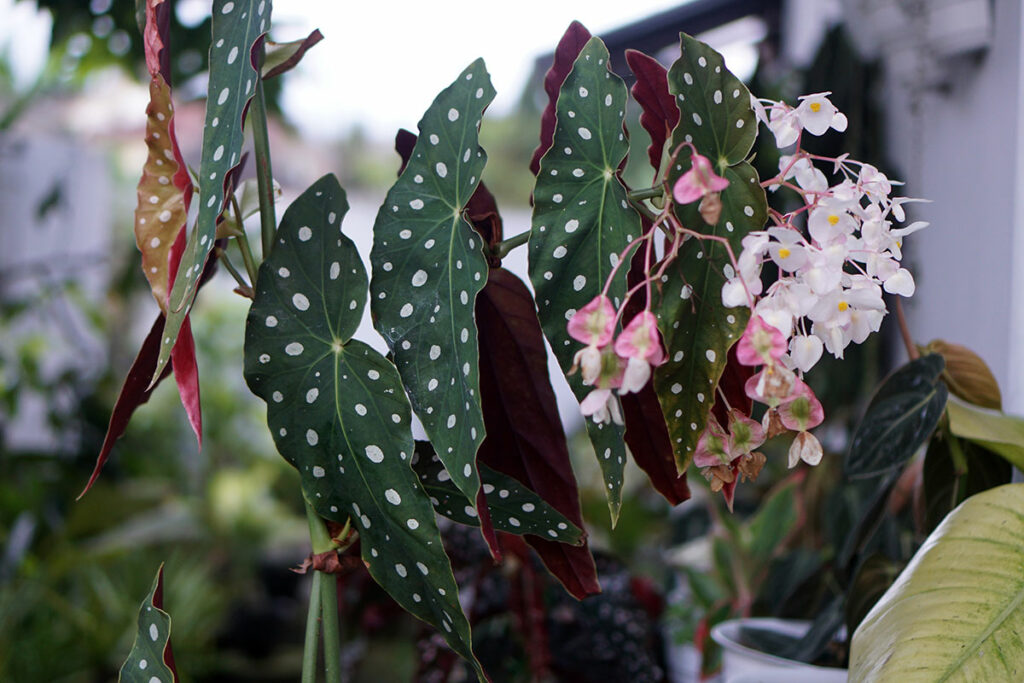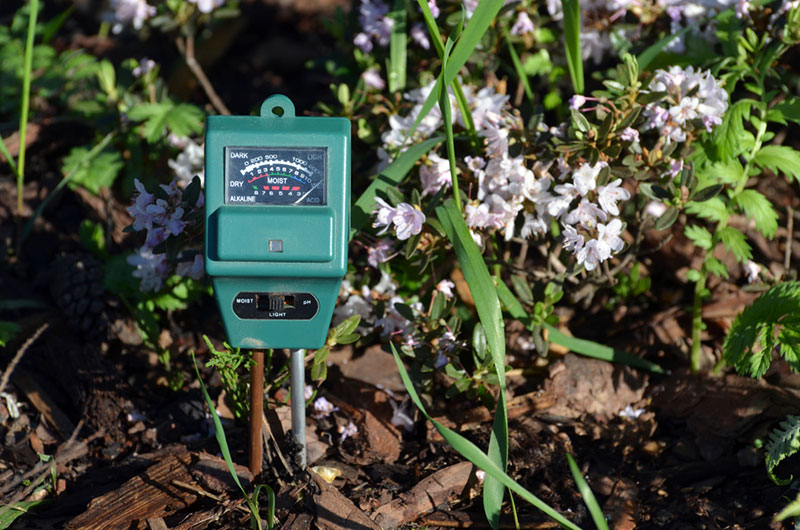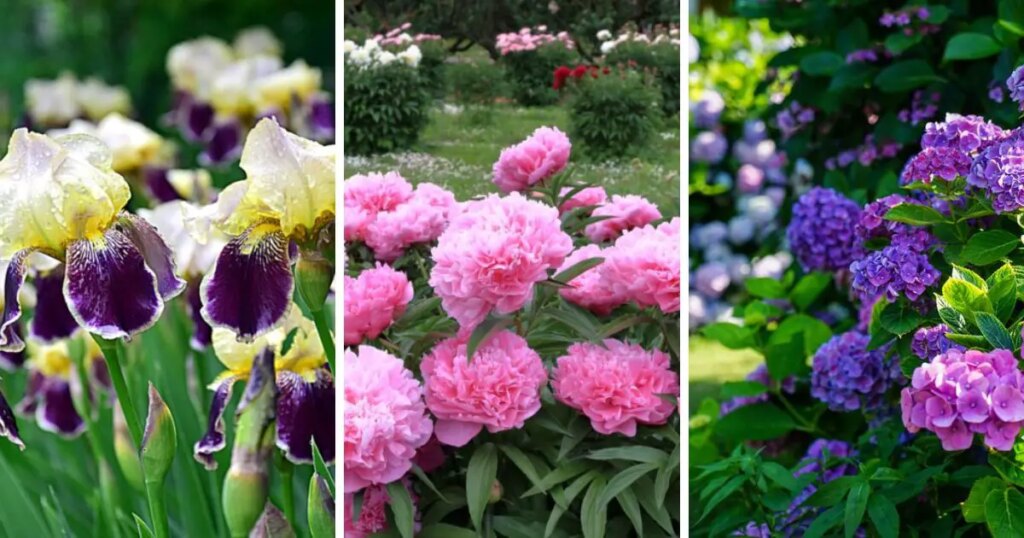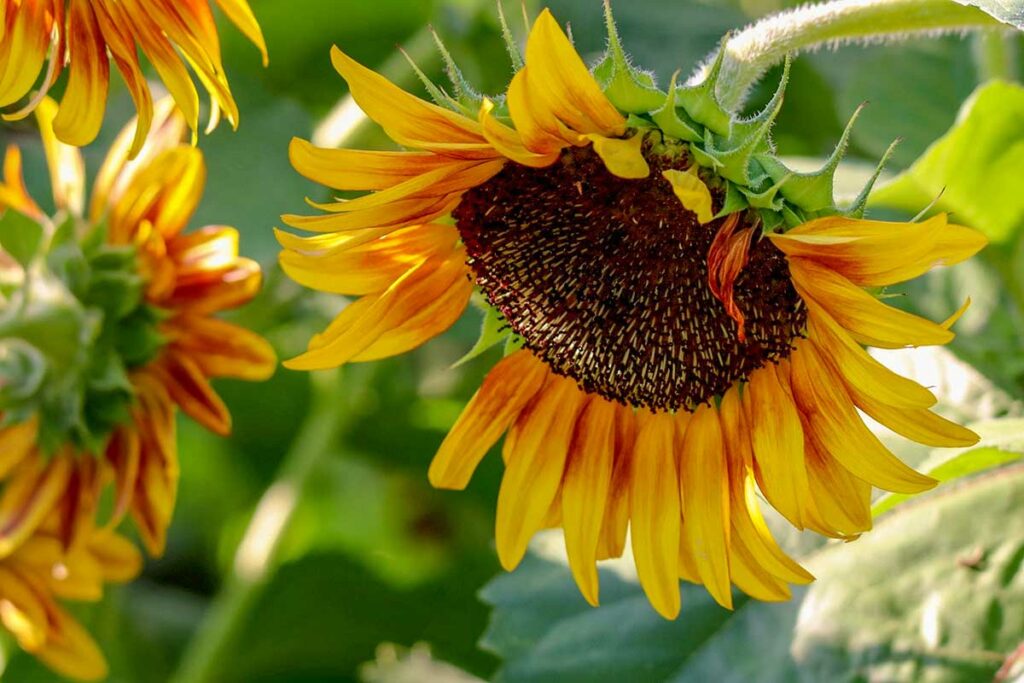
Sunflowers are known for their vibrant colors and large, showy blooms that have the power to turn any garden into a visual masterpiece. These gorgeous flowers not only add beauty but also attract pollinators and provide food for birds and animals.
As a gardening enthusiast, you might be wondering how you can keep your sunflowers blooming big and bright all summer long.
To achieve this, it’s essential to consider several factors ranging from choosing the right sunflower variety to providing the proper care.
With some attention to detail and a bit of nurturing, you can enhance your outdoor space with an eye-catching array of sunflowers that will bloom magnificently throughout the season.
Key Takeaways
- Choose the right sunflower variety suited for your garden’s conditions
- Apply proper planting techniques and maintenance to encourage growth
- Support your sunflowers with stakes and ensure ideal growing conditions
Selecting the Right Sunflower Variety
When you want your sunflower garden to bloom big and bright all summer long, it’s important to choose the right variety of sunflowers. There are several types to consider, each with its own unique characteristics and bloom time.
Dwarf Sunflowers are perfect for smaller spaces or container gardens. With their shorter height, typically reaching 1-3 feet tall, they add a lovely pop of color without taking up much room. Some popular dwarf varieties include ‘Teddy Bear’, ‘Big Smile’, and ‘Elf’.
Medium Height Sunflowers typically grow between 4-6 feet tall, making them a versatile choice for a variety of garden spaces. These sunflowers still produce large blooms in a range of colors like yellow, red, and orange. A few popular medium height varieties are ‘Autumn Beauty’, ‘Evening Sun’, and ‘Indian Blanket’.
Giant Sunflowers are the showstoppers of the sunflower world. Reaching heights of up to 15 feet or more, these stunning sunflowers produce enormous blooms that can be over a foot in diameter. If you have the space and really want to make an impression, consider planting varieties like ‘Russian Giant’, ‘Mongolian Giant’, or ‘American Giant’.
When selecting sunflower seeds, look for ones that have been treated with a fungicide to protect against diseases. You can also opt for seeds with a high germination rate or those that are “heirloom” varieties, ensuring a healthier plant and more consistent blooms throughout the summer.
Another essential factor is the bloom time. Some sunflower varieties bloom early in the season and others late, so mixing early, mid, and late-season bloomers can help to ensure that your sunflower garden remains bright and colorful throughout the summer months. Check the seed packets or description for information on bloom time.
By considering the size, color, and bloom time of different sunflower varieties, you can create a stunning garden that will keep your yard looking vibrant and cheerful all summer long.

Proper Planting Techniques
Seed Preparation
To ensure your sunflowers bloom big all summer long, start by properly preparing the seeds. Soak them in water for 12-24 hours before planting to promote faster germination. Once the seeds have soaked, drain the water and pat them dry using a clean cloth or paper towel.
Planting Location
Location matters – and that’s certainly true when it comes to sunflowers. Choose a spot in your garden that receives at least 6-8 hours of sunlight each day. Sunflowers thrive in well-drained soil with a pH between 6.0 and 7.5. To provide additional nutrients, you can also mix in compost or aged manure to the soil before planting.
Planting Time
Timing is crucial for sunflower success. Plant the seeds in the spring, after the danger of frost has passed. You can start seeds indoors if you want a head start on the growing season, but be sure to transplant them outdoors after the last frost date. When planting the seeds, space them about 6-12 inches apart and cover them with 1-2 inches of soil.
By following these proper planting techniques, your sunflowers should have a great start to bloom big and bright all summer long!
Ideal Growing Conditions
Soil
To help your sunflowers thrive, it’s important to prepare the right soil. Sunflowers prefer well-draining soil with a pH between 6.0 and 7.5. You should add organic matter, such as compost, to improve the soil’s texture and nutrient content. This will create a fertile environment for your sunflower’s roots to grow and help them access the essential nutrients they need.
Water
Your sunflowers will require consistent hydration, so be prepared to water them regularly. Ideally, provide them with about 1 inch of water per week. Deep, thorough watering encourages strong root growth, which in turn helps your sunflowers remain healthy and robust throughout the summer. However, be cautious of overwatering — too much water may cause the roots to rot and the plant to suffer.
Sunlight
Sunlight is crucial for sunflower growth. Make sure you choose a spot in your garden or outdoor space where your sunflowers will receive at least 6 to 8 hours of direct sunlight every day. The more sun exposure they get, the bigger and brighter their blooms will be.
Temperature
Sunflowers thrive in warm temperatures, making summer the perfect season for them. Generally, they grow best in temperatures between 70°F and 78°F (21°C and 26°C). During the initial stages of growth, however, they can tolerate cooler temperatures. So, if you’re starting your sunflowers from seeds, you can plant them outdoors a couple of weeks before your area’s last estimated frost date.
Once they’re established and temperatures rise, they’ll take off and produce those stunning, large blooms you’re after.

Nourishment and Maintenance
Sunflowers thrive with proper nourishment and maintenance. In this section, we’ll explore the essential steps to keep your sunflowers blooming big all summer long, including fertilizing, weeding, and mulching.
Fertilizing
Proper fertilization is crucial for sunflower growth. Start by testing your soil and applying the recommended amendments. Generally, sunflowers benefit from a balanced fertilizer with a ratio of 10-20-10 (nitrogen, phosphorus, and potassium).
- Apply fertilizer when first planting, and again during the growing season.
- Be sure not to over-fertilize, as this can lead to excessive growth and weak stems.
Weeding
Weeds can compete with your sunflowers for nutrients, water, and sunlight. Keeping the area around your sunflowers weed-free will help them thrive.
- Regularly check your sunflower bed for weeds and remove them by hand or with a hoe.
- Avoid using chemical weed killers, as they can harm your sunflowers and other plants.

Mulching
Mulching is an essential step for maintaining healthy sunflowers. It helps regulate temperature, retain moisture, and prevent the growth of weeds.
- Add a 2-3 inch layer of organic mulch (such as wood chips, straw, or grass clippings) around the base of your sunflowers.
- Replenish the mulch throughout the summer as needed.
By following these steps, you’ll provide the nourishment and maintenance needed for your sunflowers to bloom big all summer long. Their bright and cheerful presence will be a delightful addition to your garden.
Pruning and Deadheading
To keep your sunflowers blooming big all summer long, it’s important to regularly prune and deadhead your plants. By doing so, you’ll encourage the growth of new, healthy flowers, and make sure your sunflowers look their best.
Begin by inspecting your sunflower plants closely. Look for any damaged or wilted leaves and remove them using a pair of sharp, clean pruning shears. This allows the plant to focus its energy on producing healthy and strong blooms.
Next, take a look at the flowers themselves. When you notice a bloom starting to wilt or lose its petals, it’s time to deadhead. Snip off the faded flower head just below where it meets the stem, making sure not to damage any nearby buds. This will signal to the plant to produce more flowers.
Remember to water your sunflowers regularly, especially during the warmer months. They prefer evenly moist soil, so make sure you don’t let the soil dry out completely. It’s better to water deeply and infrequently instead of frequent light watering.
Lastly, consider providing your sunflowers with a balanced fertilizer every few weeks. This helps to promote the growth of blooms and ensures that your sunflowers have the nutrients they need for healthy flowering.
By following these simple tips on pruning and deadheading your sunflowers, you’ll be able to enjoy big, beautiful blooms all summer long.
Support and Staking
Sunflowers are known for their tall stems and large, vibrant blooms. To keep your sunflowers looking their best all summer long, it’s important to provide them with proper support and staking. This will ensure they remain upright and healthy throughout the season.
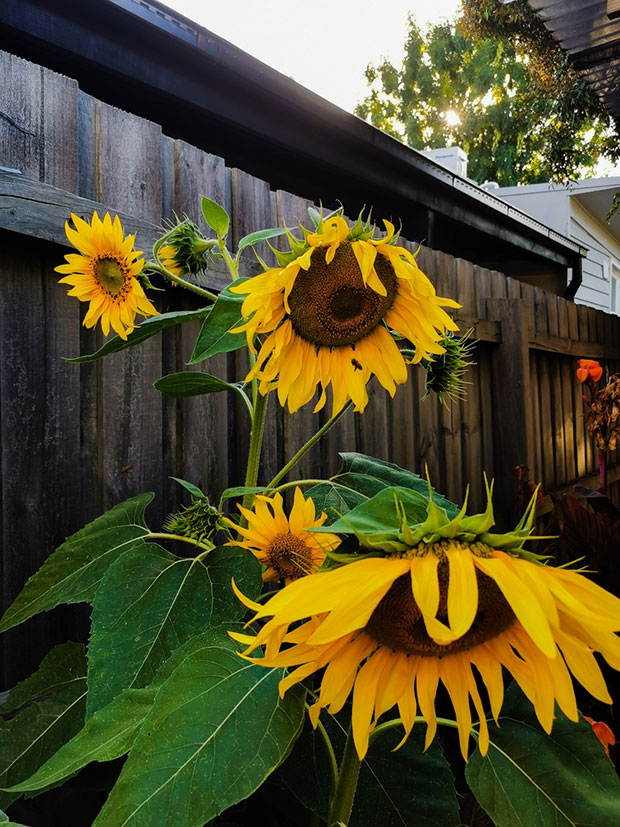
First, you should choose the right stakes for your sunflowers. Bamboo stakes or metal garden stakes are popular options, as they are durable and strong enough to support a growing sunflower. The stake should be at least two-thirds the height of your fully grown sunflower, allowing the plant to have ample room to grow.
When your sunflower is about 2 feet tall, you can start staking it. To do this, gently push the stake into the ground about 6 inches away from the base of the sunflower. Be sure to avoid damaging the root system in the process. As the sunflower grows, attach it to the stake using a soft material like gardener’s tape, twine, or soft cloth strips. This will help prevent any damage to the stem as it enlarges.
As your sunflower continues to grow, you may need to adjust the staking. Keep an eye on the plant’s progress, and make any necessary adjustments to ensure it remains secure and well-supported. Don’t forget to check the connections between the stake and the sunflower stem, making sure they are snug but not too tight. This will allow the stem to continue growing without constriction.
In addition to staking, you can also provide support for your sunflowers by planting them in groups. Sunflowers planted together can lean on one another for support, which can reduce the need for additional staking. This technique works well for smaller varieties of sunflowers, but keep in mind that larger sunflowers may still require staking to prevent them from falling over.
By following these tips on properly supporting and staking your sunflowers, you can ensure they stay upright and beautiful all summer long.









